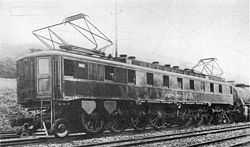PRR FF1
| PRR FF1 | |
|---|---|
 | |
| Type and origin | |
| Power type | Electric |
| Builder |
Altoona Works with Westinghouse |
| Build date | 1917 |
| Total produced | 1 |
| Specifications | |
| AAR wheel arr. | 1-C+C-1 |
| UIC classification | 1′C+C1′ |
| Gauge | 4 ft 8 1⁄2 in (1,435 mm) |
| Leading wheel diameter | 36 in (914 mm) |
| Driver diameter | 72 in (1,829 mm) |
| Length | 76 ft 6 in (23.32 m) |
| Height | 14 ft 8 in (4.47 m) |
| Weight on drivers | 439,500 lb (199.4 tonnes) |
| Locomotive weight | 516,000 lb (234.1 tonnes) |
| Electric system(s) | 11 kV 25hz AC |
| Current collection method | Catenary |
| Traction motors | 4 × Westinghouse model 451 1,910 hp (1,420 kW) three-phase motors |
| Transmission | Rotary converter supplied 25Hz three phase alternating current fed to motors able to run at one of two speeds and connected to the drivers through Jackshafts and side rods |
| Performance figures | |
| Maximum speed | 20.6 mph (33.2 km/h) |
| Power output | 4,600 hp (3,400 kW) |
| Tractive effort |
Continuous: 87,200 lbf (388 kN) Starting: 140,000 lbf (620 kN) |
The Pennsylvania Railroad's class FF1 was an American electric locomotive, a prototype numbered #3931 and nicknamed "Big Liz". It was built in 1917 to haul freight trains across the Allegheny Mountains where the PRR planned to electrify. "Big Liz" proved workable but too powerful for the freight cars of the time with its 4600 available horsepower and astonishing 140,000 pounds of tractive effort. Pulling the train it regularly snapped couplers and when moved to the rear as a pusher its force was sufficient to pop cars in the middle of the train off the tracks.

It had a 1-C+C-1 wheel arrangement in two half-frames, connected in the center. Each frame had a pair of three phase AC induction motors driving a jackshaft through gearing and a spring drive; side rods then drove the wheels. Three phase power for the 4 massive motors was supplied from the single phase overhead supply via a large rotary converter housed in the body of the locomotive. Combined rated output of the motors was 7640 hp, but the converter could only supply a short term 4600 hp or a continuous 4000 hp. With three-phase induction motors there was no way to control the speed of the motors; changing the wiring of the motor poles allowed for two speed settings, 10.3 mph and 20.6 mph, which were considered enough to drag heavy freight trains up and down steep grades.
Its intended use as an Allegheny climber never realized and its power too much for the rolling stock in service at the time, Big Liz was sidelined until being cut up for scrap in 1940.
References
- Staufer, Alvin (1962). Pennsy Power. Staufer. pp. 248–253. ISBN 0-944513-04-2. LOC 62-20878.
- Pennsylvania Railroad (July 1917). "Pennsylvania Electric Locomotive - Experimental Design for Heavy Trunk Line Service to Operate Over 24 Miles of One Per Cent Grade" (PDF). Railway Mechanical Engineer 91 (7): 389–390.
- Pennsylvania Railroad (February 1918). "Pennsylvania Electric Locomotive - A Description of Interesting Details in the Running Gear Construction and in the Electrical Equipment" (PDF). Railway Mechanical Engineer 92 (2): 87–90.
| ||||||||||||||||||||||||||||||||||||||||||||||||||||||||||||||||||||||||||||||||||||||||||||||||